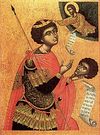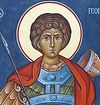 Apostles of the Seventy Erastus, Olympas, Herodion, Sosipater, Quartus, and Tertius (Terence) (1st c.).
Apostles of the Seventy Erastus, Olympas, Herodion, Sosipater, Quartus, and Tertius (Terence) (1st c.).
Commemoration of the beginning of the torture of Great-martyr George (303). Martyr Orestes the Physician, of Cappadocia (304). Hieromartyr Milos (Miles), bishop in Persia, and his disciples, Martyrs Aborsam and Senoe (ca. 341). Great-martyr Constantine-Kakhi, prince of Kartli, Georgia (852). St. Theocteristus, abbot, of Symbola Monastery on Mt. Olympus in Bithynia. Glorification of St. Matthew, monk, of Yaransk (1997).
New Hieromartyrs Procopius (Titov), archbishop of Kherson, and Seraphim (Gushchin), hieromonk of Optina Monastery (1931). New Hieromartyrs Augustine (Belyaev), archbishop of Kaluga, and with him Ioannicius (Dmitriev), archimandrite, of the St. George Monastery (Meshchevsk), Niphon (Vyblov), hieromonk, of Berezovy Khutor (Saratov), and John Speransky, archpriest, of Kaluga (1937). New Martyrs Alexis Gorbachev, Apollonius Babichev. and Michael Arefeyev, Nicholas Smirnov, Anna Ostroglazova (1937-1939). New Martirs Olga Maslennikova (1941) and Theoctista Chentsova (1942).
St. Eucharius, first bishop of Trier (3rd c.). St. Nonnus, bishop of Heliopolis (471). St. Justus, archbishop of Canterbury (627- 631). Ten Martyrs of Gaza, at Jerusalem: Callinius, Imerius, Diasimus, Theodore, Stephen, Peter, Paul, Theodore, John, and John (638). Translation of the relics of St. Gregory, bishop of Assos near Ephesus (1150).
Monday. [II Thess. 1:1-10; Luke 12:13-15, 22-31]
Who made Me a judge or a divider
over you? the Lord said to the man who asked Him to
divide between him and his brother. Then He added: take
no thought (Matt. 6:33), about what to eat and drink,
or what to wear. Earlier He taught: leave the dead to bury
their dead; another time he suggested that it is better
not to marry. This means that the attention and heart of
Christians turning aside from everything worldly, and
freedom from worldly talk and bonds, make up one of the
traits of a Christian spirit. That the Lord blesses
marriage and supports its integrity, which effectually
renews the commandment regarding the relationship between
parents and children and attaches significance to civic
powers and order, is not a negation of this trait and does
not give Christians the right to avoid preserving and
cherishing it in their hearts. Compare both things and you
will see that you have a duty to keep your heart unworldly
amidst worldly routines. How can one do this? Figure out
your life yourself; in this is all practical wisdom. The
Lord guides one towards solving this with the following
rule: seek ye first the kingdom of God. Direct all
your concern towards having God reign in you, and
everything worldly will lose its binding and burdensome
spell over you. Then you will conduct your affairs
outwardly, but inwardly your heart will be possessed with
something else. But, if on account of this, the resolution
arises to cut off this outer relationship to worldly
things—you will not lose out: you will come closer
to the goal which the faith of Christ will give
you.


![]() Apostles of the Seventy Erastus, Olympas, Herodion, Sosipater, Quartus, and Tertius (Terence) (1st c.).
Apostles of the Seventy Erastus, Olympas, Herodion, Sosipater, Quartus, and Tertius (Terence) (1st c.). 

















